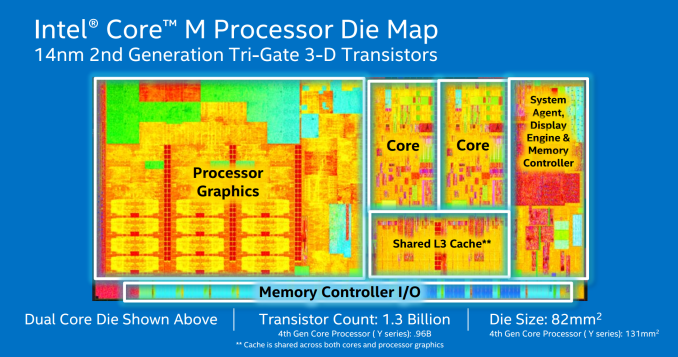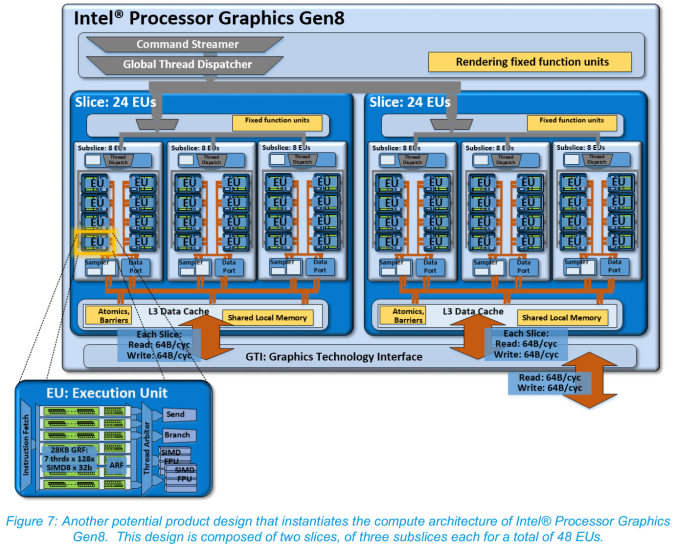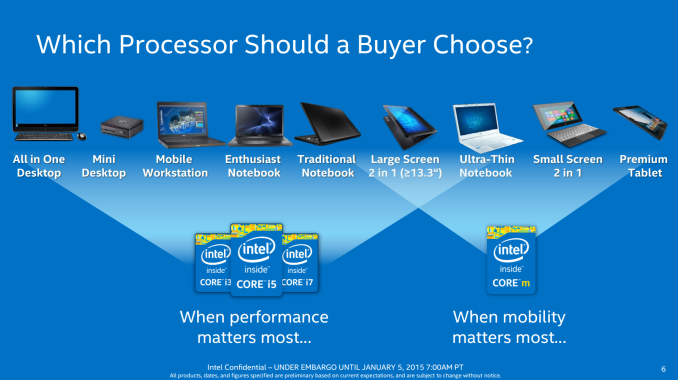Analyzing Intel Core M Performance: How 5Y10 can beat 5Y71 & the OEMs' Dilemma
by Brett Howse & Ian Cutress on April 8, 2015 8:00 AM EST
A processor architect can battle between two major opposing principles. The one most of us seem to enjoy is performance, which when taken to the extreme exhibits an all-or-nothing approach. At the other end is low-power operation which has become the main focus of the laptop and notebook market where battery capacity and density is at a premium. The position in the middle of this is efficiency, trying to extract the best of performance and power consumption and provide a product at the end of the day which attempts to satisfy both.
Of course processor architects only have control up to the point where the chips leave the fab, at which point the final product design is in the hands of OEMs, who for various reasons will have their own product design goals. It's this latter point that has resulted in an interesting situation developing around the Core M ecosystem, where due to OEM design goals we've seen the relative performance of Core M devices vary much more than usual. In our tests of some of the Core M notebooks since the beginning of the year, depending on the complexity of the test, the length of time it is running and the device it is in, we have seen cases where devices equipped with the lowest speed grades of the Core M processor are outperforming the highest speed grade processors in similar types of devices, an at-times surprising outcome to say the least.
Never content to leave things alone, we wanted to take a look at the performance in Core M in depth and how device design - particularly cooling design - can significantly impact performance. So for today we will be diving deep into Core M, to see what we can test and what can be said about system design as a whole for the mini-PC, notebook, tablet and 2-in-1 ecosystem.
Core M
First, let us loop back to the design of Core M, which historically sits in the ‘Y’ processor stack and goes by the codename Broadwell-Y. Core M only comes in dual core flavors with Hyperthreading, with an official TDP of 4.5 watts. Each model comes with 4MB of L3 cache and Intel’s 8th generation of graphics architecture under the designation HD 5300.
HD 5300 is technically a 24 execution unit design, consisting of a major slice with three sub-slices of eight execution units each. This is double the GT1 / HD (Haswell) design where Intel enables only 12 units (which has benefits when it comes to enhancing yields), or half the full GT3 implementation which keeps the same front end but doubles the major slices. A full on 48-EU design looks something like this, although Core M only has one major slice.
The three main differentiators between each of the SKUs in the Core M line are the processor base frequency, the processor turbo frequency and the integrated graphics frequency range. A number of the processors also support cTDP Up and cTDP Down modes which adjust the base frequency of the processor only. Core M supports Turbo Boost Technology 2.0 which allows individual cores of the silicon to increase in frequency within specified parameters, which may include workload, estimated current/power consumption, and temperature. These two points are key to the rest of the article.
| Core M Specifications | |||||||
| Model Number | 5Y71 | 5Y70 | 5Y51 | 5Y31 | 5Y10c | 5Y10a | 5Y10 |
| Cores/Threads | 2 Cores / 4 Threads | ||||||
| CPU Base/ Boost Frequency |
1.2 GHz 2.9 GHz |
1.1 GHz 2.6 GHz |
1.1 GHz 2.6 GHz |
0.9 GHz 2.4 GHz |
0.8 GHz 2.0 GHz |
0.8 GHz 2.0 GHz |
0.8 GHz 2.0 GHz |
| GPU Base/ Boost Frequency |
300 MHz 900 MHz |
100 MHz 850 MHz |
300 MHz 900 MHz |
300 MHz 850 MHz |
300 MHz 800 MHz |
100 MHz 800 MHz |
100 MHz 800 MHz |
| TDP | 4.5 W | 4.5 W | 4.5 W | 4.5 W | 4.5 W | 4.5 W | 4.5 W |
| cTDP Down (CPU Base) |
3.5 W 600 MHz |
No | 3.5 W 600 MHz |
3.5 W 600 MHz |
3.5 W 600 MHz |
No | No |
| cTDP Up (CPU Base) |
6.0 W 1.4 GHz |
No | 6.0 W 1.3 GHz |
6.0 W 1.1 GHz |
6.0 W 1.0 GHz |
No | No |
| Intel vPro | Yes | Yes | No | No | No | No | No |
Core vs. Atom
In general, Core M is a small departure from Intel (pun intended), bringing its main Core processor architecture, typically used for big core performance, down to power levels and chip sizes better suited for fanless laptops and tablets. Despite the drop in core counts and frequency to reach 4.5 watts, the Core M line typically has a single threaded performance advantage at this power segment as compared the competition, which is no simple achievement.
For Intel, this 4 to 5 watt TDP window for processors has typically been occupied by the Atom line of integrated SoCs. In 2014 this meant Silvermont cores in a Bay Trail system produced at the 22nm process node, but for 2015 will mean Airmont cores in a Cherry Trail system at 14nm. For most of 2014, Atom competed against high powered ARM SoCs and fit in that mini-PC/tablet to sub 10-inch 2-in-1 area either running Android, Windows RT or the full Windows 8.1 in many of the devices on the market.
Despite Intel’s initial long cadence with Atom, we are seeing them step up to the plate and provide an iterative cycle that allows for the latest node technologies combined with the updated graphics technology from the integrated Core ecosystem. Nevertheless, Intel has split this 4 to 5 watt TDP segment into two clear formats based on performance and price.
Atom sits at the lower price band ($50-$100 per chip), typically in a dual or quad core arrangement without hyperthreading and uses ‘modules’ of two discrete cores sharing an L2 cache. The integrated IO is designed to be enough for this market segment, as seen in the recently announced Surface 3, and shows that devices in the $500 region are ripe for the next Atom SoCs. Note that Braswell, which also uses Airmont cores at 14nm but goes under the Celeron/Pentium nomenclature, also sits in this 4 to 6 watt region but is aimed more at the mini-PC arena.
Intel lists all of the Core M processors at $281, and a user will be hard pressed to find a Core M device priced under $700 on the market now; such is the gap that Intel wants to strike with the two platforms. Core M sits at the heart of the new Macbook (read our hands on), as well as most of the devices in this test such as the ASUS UX305, Lenovo Yoga 3 Pro and the Dell Venue 11 Pro 7000. With the Broadwell architecture and hyperthreading under its belt, the results do speak for themselves as Core M attacks the Haswell-U line from the last 18 months in terms of direct performance.













110 Comments
View All Comments
xilience - Wednesday, April 8, 2015 - link
Minor issue with one of the graphs. PCMark8 Home graph, the temperature scales are different for each device, whereas they look to be the same for all other tests. The numbers are correct, but when quickly comparing graphs it can be confusing to read. THANKS for this great article, it gives a lot of insight into mobile hardware design.digiguy - Wednesday, April 8, 2015 - link
Very interesting article. Core M makes sense (contrary to what some people say in the comments) for those that have the money and want a totally silent device.Having said that, some ultrabooks and core tablets (like my 35W TDP Asus ultrabook or my surface pro 3 i3) are extremely silent, with the fan kicking in only while gaming, which in my opinion is a small concession in exchange for sustained performance (zero throttling in either of the 2 devices).
Also the race to the thinnest device is probably questionable, especially for laptops. Making a smaller device with a bigger screen like Dell did is a great idea, making it thinner and thinner doesn't add much and subtracts performance or adds heat.
What a pity you didn't add the new Macbook to the comparison (probably not available yet). Hope you will do an updated version with it. It will also allow to see how 5y71 performs in a laptop, rather than in a convertible/tablet.
TEAMSWITCHER - Wednesday, April 8, 2015 - link
The problem with just making devices thicker and adding fans is that it compromises portability for only a little in extra performance.For nearly a decade, I carried around a 15" PowerBook or MacBook Pro. Good machines but only mid-range graphic performance. Recently, I slimmed down to an 11" MacBook Air, and I will never...ever...go back to lugging around a larger device.
I also have a desktop Windows Workstation for performance oriented work. It's much faster than any laptop you can buy. Using Drop Box and One Drive I keep files synced between the two machines, and can just hop-up from my Workstation, grab my Mac Book, and hit the door.
Thankfully, my computer budget is large enough to afford a Workstation and a Mac Book - it's actually a necessity for cross-platform developers. I get extreme performance from my workstation and extreme portability from my Mac Book. I don't have to live with compromises, I just have to switch devices.
Refuge - Wednesday, April 8, 2015 - link
I'm all for small form factors and portability, I notice the difference between my 15 inch laptop and my girlfriends 10 inch convertable. It is substantial, but I don't feel that going thinner is the way anymore.The increase in portability I feel personally is purely from the decrease in screen size which naturally lowers the dimensions and weight of the device considerably, but some of these are getting so thin that they are actually uncomfortable, I don't want to hold a blade, or a brick, give me a thing (but not a blade like thin) laptop with a 11 inch screen for on the go work, make it cool, quiet, and perform, and make it like an inch thick, then knock it from $1,000 to $500. I'll buy it everytime.
I feel the same way about phones, I don't want my next one to be thinner, or have a bigger screen.
5 inches fits my hand perfectly, I don't work or game on it. I use it to pass time reading Anandtech or communicating with the world.
I game at home on my SFF that I can easily take to a lan party, or I work on my portable but not paper thin laptop.
I'm happy in all regards honestly. But I suppose this just comes down to personal preference much like how nice peripherals are comes down to taste in the end barring any insufferable design choices.
wallysb01 - Thursday, April 9, 2015 - link
"5 inches fits my hand perfectly"That's what she said.
digiguy - Wednesday, April 8, 2015 - link
"The problem with just making devices thicker and adding fans is that it compromises portability for only a little in extra performance."I think it's actually the contrary, if we talk about laptops/ultrabooks. There can be a big increase in performance for very little increase in thinkness and noise. My ultrabook has a 35w mobile second generation i7 that still performs better than any 4th gen i7 ULV CPUs, let alone Core M... And still it's thin, light and with 8 hours battery life. It is so silent that the fan won't kick in even when I do an OCR of a 10 page file...
For tablets it's different, but still, my SP3 (i3) is thin and has a fan, that never kicks in... Only while gaming, and I am actually happy it does, cause this way there is no throttling.... I would want it to be fanless.... (as I wouldn't like the fan to kick in more often like in the i5 and especially i7 models).
digiguy - Thursday, April 9, 2015 - link
Sorry in the last sentence I meant "I wouldN'T want it to be fanless"Krysto - Wednesday, April 8, 2015 - link
> Atom sits at the lower price band ($50-$100 per chip), typically in a dual or quad core arrangement without hyperthreading and uses ‘modules’ of two discrete cores sharing an L2 cache.More like $107-$161 going by your previous "Braswell" article.
What I'd like to see is how does the $281 Core-M compare to the ~$100 Haswell Celeron from the previous generation in terms of performance.
smilingcrow - Wednesday, April 8, 2015 - link
Brawell is a different market sector though so pricing may not be comparable.kyuu - Wednesday, April 8, 2015 - link
He was referring to mobile atoms (the ones that compare directly to Core M). Braswell is a different market segment, as smilingcrow said.